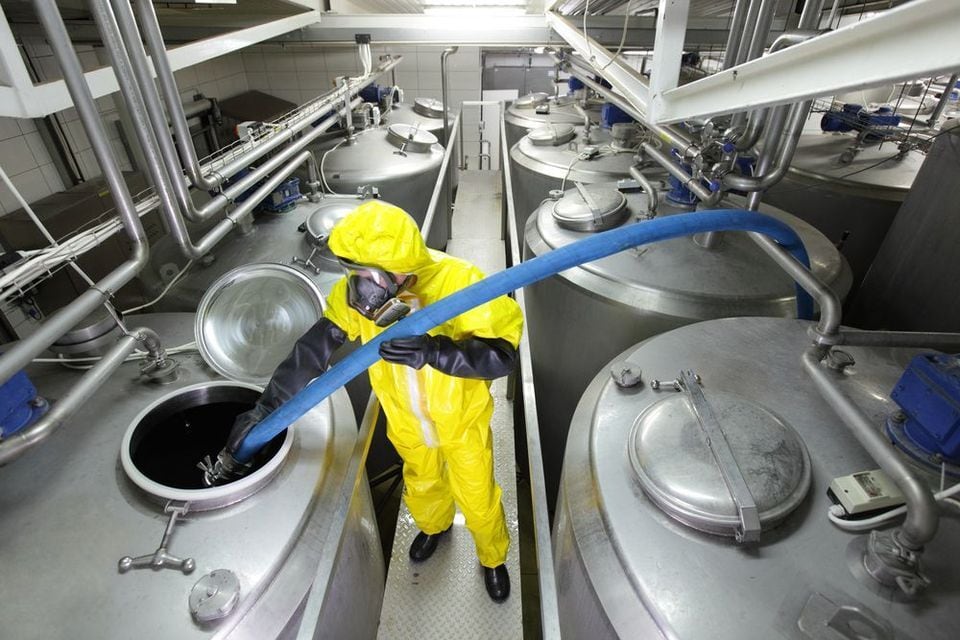At a glance
- NIOSH conducts research and makes recommendations to support the safe use of chemicals in the workplace.
- The NIOSH Pocket Guide to Chemicals Hazards includes information and recommendations for approximately 700 chemicals.
- NIOSH and partners have developed other resources for chemical safety in the workplace.

Overview
Chemicals are an important part of nearly every workplace, from specialized industrial chemicals to everyday cleaning products.
Ensuring the safe use of workplace chemicals has been a focus of NIOSH research since its founding in 1970. NIOSH research related to chemicals includes:
- Toxicity studies
- Occupational epidemiology
- Studies of how to measure chemicals in the work environment
- Studies of engineering controls and personal protective equipment (PPE)
- Risk assessment
- Health Hazard Evaluations (HHEs)
- Communication tools for understanding and managing chemicals safely at work
Best practices
NIOSH Pocket Guide to Chemical Hazards has industrial hygiene information, including NIOSH recommendations, on approximately 700 chemicals and classes of chemicals found in the workplace.
NIOSH Skin Notation Profiles provide information supplemental to the skin notation published in the NIOSH Pocket Guide. These documents provide a summary of all relevant data used to aid in determining the hazards associated with skin exposures.
Immediately Dangerous to Life or Health Values (IDLH) are developed by NIOSH (1) to ensure that workers can escape if their respiratory protection equipment fails, and (2) to indicate a maximum level above which only a highly reliable breathing apparatus, providing maximum worker protection is permitted. Acute or short-term exposures to high concentrations of some airborne chemicals have the ability to quickly overwhelm workers. This can lead to a wide spectrum of undesirable health outcomes.
International Chemical Safety Cards
The International Chemical Safety Cards (ICSCs) provide essential safety and health information in a clear and concise way. Workers and occupational safety and health professionals can use ICSCs to understand and prevent harmful exposures. The ICSC project is a joint effort of the World Health Organization and the International Labour Organization, with the cooperation of the European Commission.
More than 1,700 ICSCs are available in English, Spanish and 13 additional languages. All cards are available on the multilingual search interface.
An international group of scientists from institutions concerned with occupational safety and health draft and review ICSCs. The international peer review process ensures the authoritative nature of the Cards. NIOSH helped initiate the ICSC effort and continues to support ICSC development by participating actively in all scientific peer review meetings.
Disclaimer
The International Labour Organization, the World Health Organization, and the European Commission shall not be responsible for the interpretation and use of the information contained in the ICSCs.
Resources
NIOSH
NIOSH Chemical Carcinogen Policy describes the methods NIOSH uses to classify chemicals as carcinogens, identify control levels, and address analytical feasibility
NIOSH Manual of Analytical Methods (NMAM) contains about 300 methods for the collection and analysis of samples for hazards in the workplace. NIOSH or its partners developed or adapted the methods and in NMAM. NIOSH also evaluates them according to established experimental protocols and performance criteria.
The NIOSH Occupational Exposure Banding Process for Chemical Risks Management can be used by occupational safety and health professionals to assess chemicals that lack an occupational exposure limit. The process allows users to quickly and accurately assign chemicals into specific categories (bands). Management can then make timely decisions based on the best available scientific information.
NIOSH Personal Protective Equipment Information (PPE-Info) Database contains Federal regulations and consensus standards for PPE.
Occupational Risk Assessment is a process for estimating health risks from exposure to various levels of workplace hazard(s).
Engineering Controls Database is a repository of NIOSH information on engineering control technology. Many of the engineering controls in this database involve controlling chemical hazards in the workplace.
NIOSH publications in healthcare provide information about procedures for assessing hazardous drugs and managing risks associated with handling them.
NIOSHTIC-2 Bibliographic Database is a searchable database of occupational safety and health publications, documents, grant reports, and other communication products supported in whole or in part by NIOSH.
NIOSH Publications and Products has Criteria Documents, Hazard Alerts, Current Intelligence Bulletins, and NIOSH Fatality and Control Evaluation (FACE) program reports on chemical and other safety hazards.
Environmental Protection Agency
Frank R. Lautenberg Chemical Safety for the 21st Century Act requires the Environmental Protection Agency (EPA) to evaluate workplace chemical exposures as well as environmental exposures. NIOSH works with EPA to provide information on occupational uses of chemicals, chemical exposures, occupational risk assessment methods, and other information.
